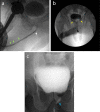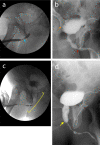Urethrocystography: a guide for urological surgery?
- PMID: 36959709
- PMCID: PMC10679595
- DOI: 10.5152/dir.2022.21640
Urethrocystography: a guide for urological surgery?
Abstract
Urethrocystography remains the gold-standard technique for urethral pathology diagnosis. Nowadays, of the various indications for performing urethrocystography, the most common is due to a clinical suspicion of urethral stricture. Due to the high prevalence of strictures and their substantial impact on a patient's quality of life, the examination must allow the location, exclusion of multifocality, and assessment of the extent of the stricture to influence surgical planning. This article intends to demonstrate that the radiologist's role, by performing and interpreting the modality of urethrocystography, influences and is crucial for the urologic therapeutic decision and that the patients who were submitted to reconstruction by urethroplasty had a better success rate. The authors aim to review the radiological anatomy of the male urethra, discuss the modalities of choice for imaging the urethra (retrograde urethrography and voiding cystourethrography), provide an overview of the different indications for performing the study, examine the different etiologies for urethral strictures, understand the relevance of the different appearances of urethral pathology, and identify the surgical options, especially in the treatment of urethral strictures. Simultaneously, the study exposes cases of urethral trauma, fistulas, diverticulum, and congenital abnormalities.
Keywords: Male urethra; radiology,; surgery; urethral stenosis; urethrocystography; urology.
Conflict of interest statement
The authors declared no conflicts of interest.
Figures












References
-
- Patel DN, Fok CS, Webster GD, Anger JT. Female urethral injuries associated with pelvic fracture: a systematic review of the literature. BJU Int. 2017;120(6):766–773. - PubMed
-
- Kawashima A, Sandler CM, Wasserman NF, Le- Roy AJ, King BF Jr, Goldman SM. Imaging of urethral disease: a pictorial review. Radiographics. 2004;24 Suppl 1:S195–S216. - PubMed
-
- Eaton J, Richenberg J. Imaging of the urethra: Current status. Imaging. 2005;17(2):139–149.
-
- Sandler CM, Corriere JN Jr. Urethrography in the diagnosis of acute urethral injuries. Urol Clin North Am. 1989;16(2):283–289. - PubMed
MeSH terms
LinkOut - more resources
Full Text Sources
Medical

